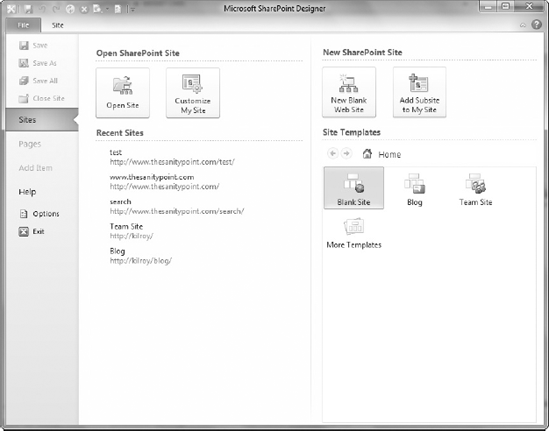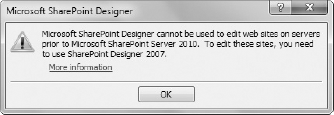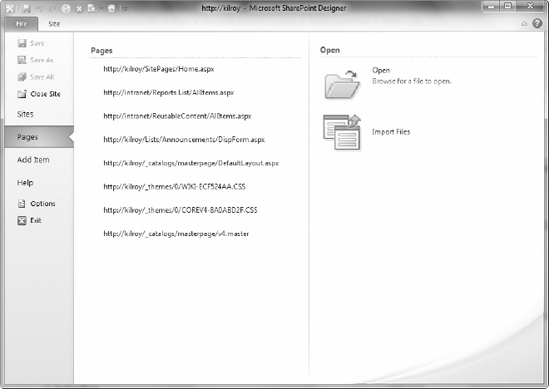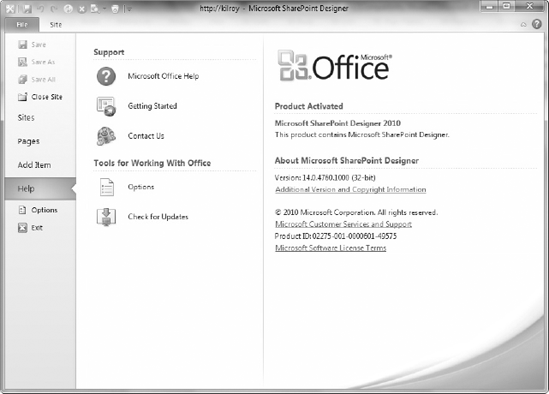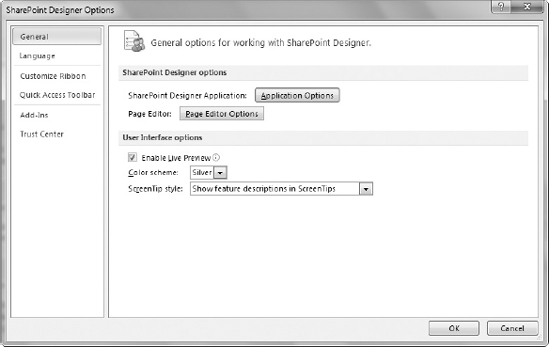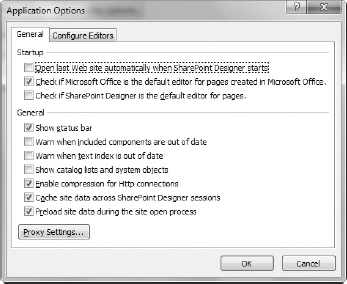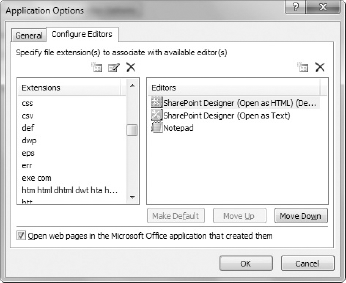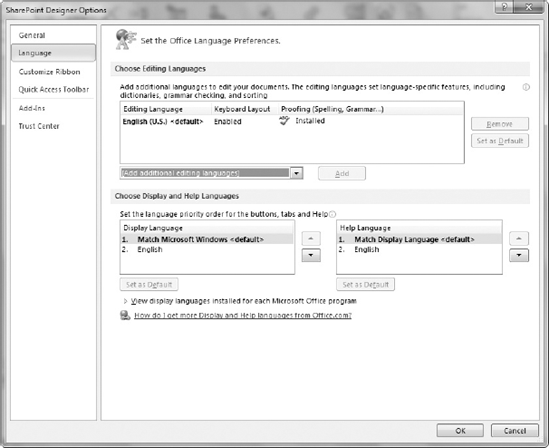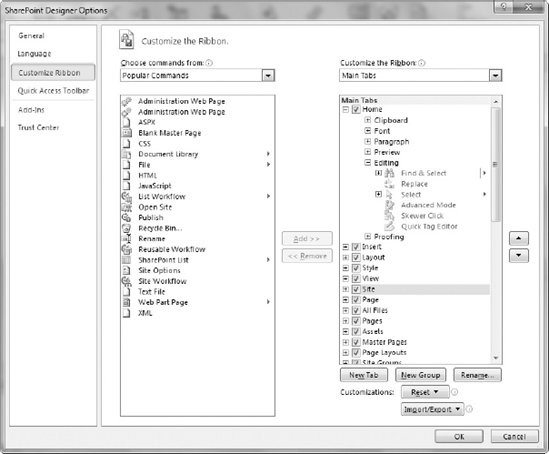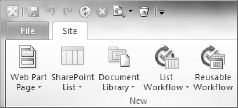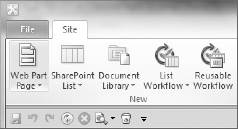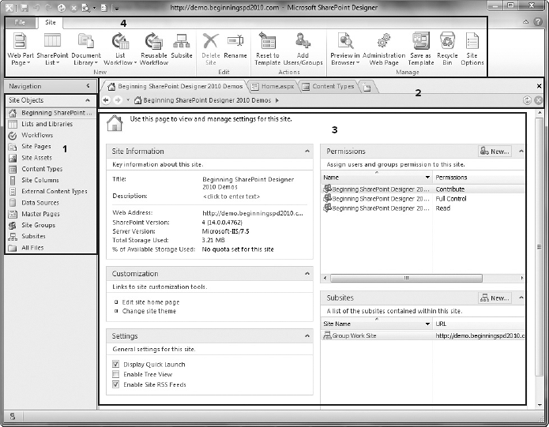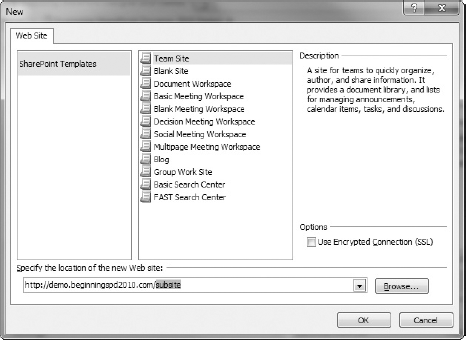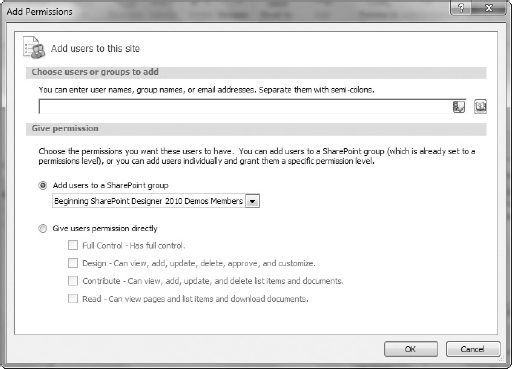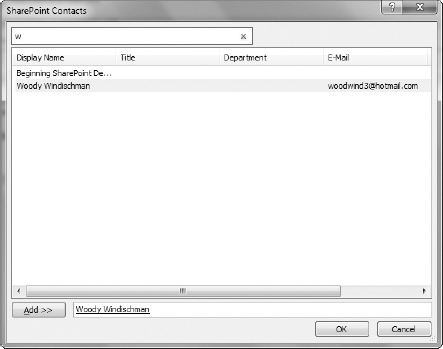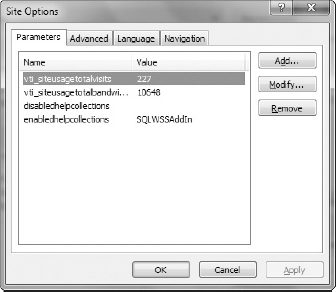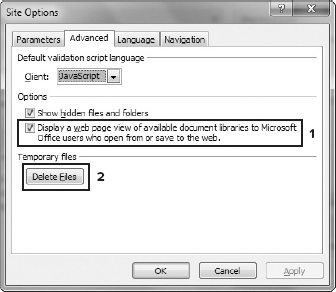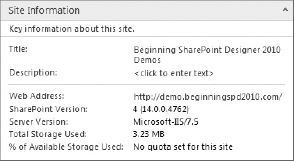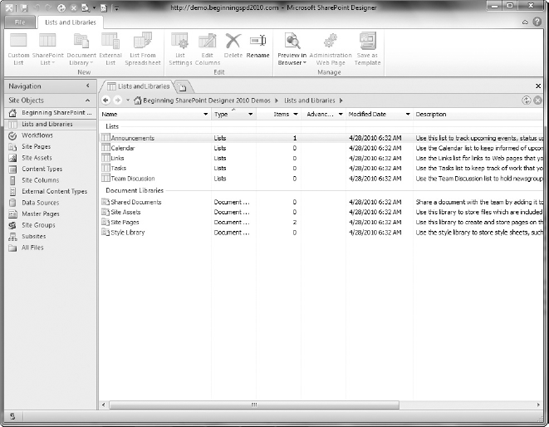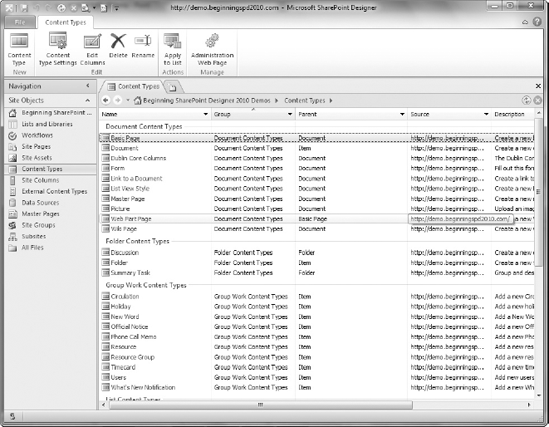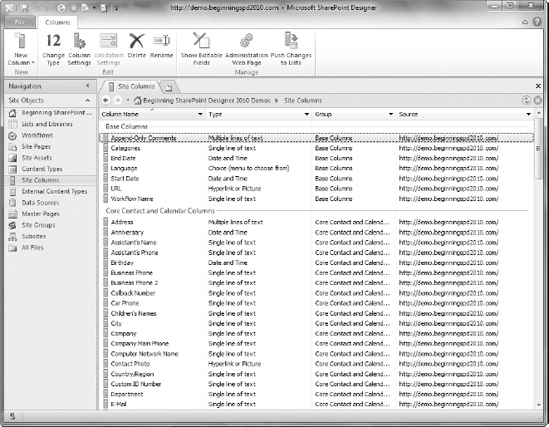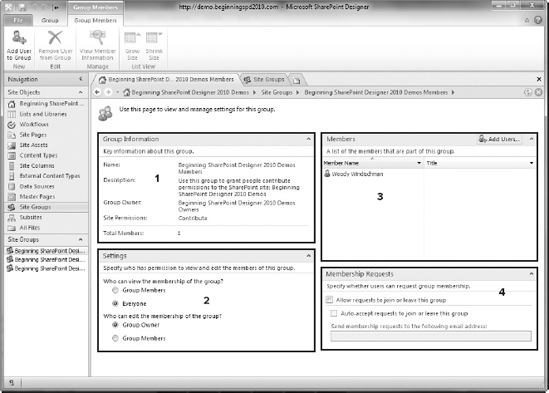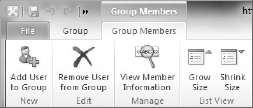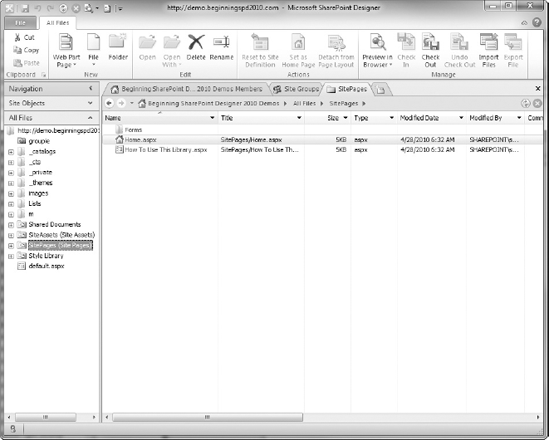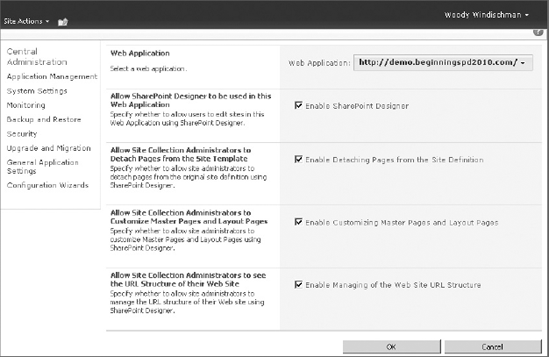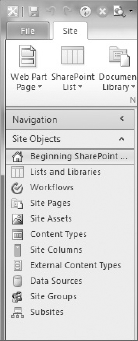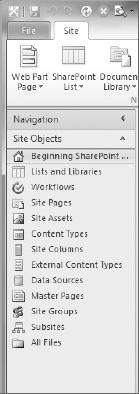WHAT YOU WILL LEARN IN THIS CHAPTER
How SharePoint Designer fits into Microsoft's toolset
SharePoint Designer's basic features
How to create a SharePoint site
How to open an existing SharePoint site
How a SharePoint site is represented in SharePoint Designer
How to change site-wide SharePoint properties
Restricting what SharePoint Designer users can do
Microsoft SharePoint 2010 is a large and sophisticated web application. It should come as no surprise, therefore, that the tool meant to customize it — Microsoft SharePoint Designer 2010 — is a large, sophisticated desktop application. Microsoft SharePoint Designer 2010 is the premier tool for customizing sites based on Microsoft SharePoint 2010. It provides features for:
Creating and editing master pages and page layouts
Creating and editing cascading style sheets (CSS)
Designing and editing workflows
Connecting SharePoint to various external data sources
Creating and modifying lists, libraries, and views of data
Managing virtually all other aspects of a user's experience in SharePoint 2010
One very important thing is not on this list: editing SharePoint content. Although SharePoint Designer 2010 does contain powerful page editing tools, these are primarily used in the service of editing the other elements described previously. SharePoint itself is a powerful web-based content management system. Site owners and users use these web-based tools to create and modify the content of their sites.
Your role as a user of SharePoint Designer is to customize the consistent presentation of that content (master pages and CSS), or rules by which it is gathered and manipulated (external data connections and workflow).
In the 2007 Microsoft Office System, Microsoft replaced many of the traditional user interface elements in several client applications, such as Microsoft Word, with what it calls the Fluent user interface, the most noticeable feature of which is a tabbed mega-toolbar called the ribbon. For 2010, this user interface has been expanded to include virtually all Microsoft client applications, including SharePoint Designer 2010. In addition, even SharePoint itself has been endowed with this very popular element (see Appendix B). Figure 1-1 shows an example of the ribbon in SharePoint Designer.
Many tabs on the ribbon are dynamic, or context sensitive, meaning that different tabs are available depending on what you are doing at the time. In Figure 1-1, for example, the tabs in the Code View Tools and List View Tools sections would only be visible simultaneously because the user is editing the design of a list view while the code view portion of SharePoint Designer's split was active. List views and the code view are described in detail later in this book.
In the 2010 client products, Microsoft has taken the Fluent UI a step further. The Office 2007 applications had a Jewel menu that replaced the traditional File menu. For 2010, the name File has been restored, but the functions under that label have expanded even further. Rather than summoning a menu, clicking on the File tab brings forth a new element that Microsoft calls Backstage. Backstage is essentially a full-screen configuration page.
Most ribbon tabs affect a specific piece of a document, such as the font of a word, or the style of a table. Backstage allows you to work with items that affect either the application itself, or the document you are working on as a whole. Different Office applications expose different levels of functionality through Backstage as appropriate. Figure 1-2 shows the SharePoint Designer Backstage.
Until you have a site open, SharePoint Designer's Backstage will only allow you to open an existing site, create a new site, or modify some program settings. After you have a site open, however, Backstage also provides options for adding new elements, or artifacts, to your site. These may include pages of various types, new lists and libraries, or even workflows.
Within Backstage, a shaded area at the left of the page contains commands and command sections. The contents of this area are shown in Figure 1-4.
Being able to tell the commands from the command sections at a glance can be difficult. One way to determine this is to observe the shape of the highlight when you hover over an option with the mouse pointer. A command, as shown in Figure 1-5, has a highlight that encircles only the text of the command. A command section, shown in Figure 1-6, is highlighted with a band that extends the entire width of the shaded area.
The first four items — Save, Save As, Save All, and Close Site — are individual commands that allow you to save a specific file being edited, all currently open files, or completely close the currently open site.
The Sites section is shown by default when you open SharePoint Designer, and was shown earlier in Figure 1-2. The four primary regions in the Sites section are:
Open Site
New Site
Recent Sites
Site Templates
Open Site and New Site each have two large buttons. "Open Site" and "New Blank Web Site" are for opening or creating a general purpose SharePoint site. The "Customize My Site" and "Add Subsite to My Site" buttons are dedicated to working with the My Site feature of SharePoint.
Note
A My Site is a special site within SharePoint Server (but not SharePoint Foundation) that contains information by, about, and for a particular user and his social network. Microsoft Office, and by extension SharePoint Designer, recognizes each user's My Site the first time it is accessed through SharePoint. After the site is recognized, the various Office applications will provide easy and direct access to this site.
If you have opened other SharePoint sites in the past, they appear in the Recent Sites region of the Sites dialog. You may click the name to select it. Double-clicking a site name in the Open Site dialog drills you into that site and allows you to choose a child site to open (if any). After you have selected a site to open by any of these methods, click the Open button to open the site in SharePoint Designer. You may be prompted to enter credentials for the website, either upon drilling down, or after clicking the Open button.
Until you close all instances of SharePoint Designer, any other site you open in the same URL domain will attempt to use the same credentials. You are prompted again if the account used does not have sufficient permission to open the new site. You may determine the current ID you are using for the open site, or log in as a different user, by clicking the small "person" icon at the far left of the status bar.
Note
Successfully opening a site in SharePoint Designer does not guarantee you can perform all editing functions on that site. See the section "Governing SharePoint Designer" later in this chapter for details on how the usage of SharePoint Designer may be limited by site administrators.
SharePoint Designer can only have one site open within an application window. If you attempt to open another site while one is currently open, the new site opens in a new instance of SharePoint Designer.
All SharePoint sites are created based upon a site definition, or template. A template defines the features available by default in that particular type of site. These typically include pre-defined lists and libraries, special pages, and default content. The Site Templates area shows certain common SharePoint templates that you may use to create a new site. Other templates may be available depending upon a server's configuration. Clicking the More Templates icon allows you to browse to a SharePoint server and retrieve the list of templates available in that installation.
The Pages section of the SharePoint Designer Backstage (File tab) enables you to retrieve recently opened files, or browse for other files to open or import. For the purposes of this section, the word "pages" is very loosely defined, and may also include layouts, style sheets, or other file types.
Figure 1-7 shows the Pages section.
When you have a SharePoint 2010 site open, you have the ability to open and edit files, not only within the current site, but from other locations as well — even those that are not SharePoint 2010 sites.
The Add Item section of Backstage gives you a convenient place to create pages and various other SharePoint artifacts without first drilling into the section dedicated to a particular type. The types of items available may vary depending upon the site you have open. Figure 1-8 shows a typical array of choices for Add Item.
You can find brief introductions to these artifacts throughout this chapter. Later chapters describe in detail how SharePoint Designer allows you to manipulate most of them.
The Help section of Backstage, shown in Figure 1-9, provides tools and information relating to SharePoint Designer itself.
The right half of the page is taken up by the "about" information. This tells you the precise version and patch level of SharePoint Designer. It also includes copyright information, as well as what licensing mode the product is in (such as Trial, or Activated).
The Support zone gives links to different kinds of help, from classic-style pop-up window help to online support resources. Certain aspects of this help are only available if you are connected to the Internet.
The Tools zone allows you to check for newer versions of SharePoint Designer, or change various program settings. These settings are described in more detail in the next section.
When you click the Options link in the Tools zone, or the options button in the Help section, instead of a new section page, the SharePoint Designer Options dialog appears. From here, you can control many aspects of your SharePoint Designer experience.
In addition, some items in the Options dialog are shared across all the Microsoft Office 2010 applications you have installed. Where an (otherwise shared) option is not relevant to your current SharePoint Designer configuration, that section of the Options dialog appears grayed out.
Like many aspects of SharePoint Designer 2010, this dialog is made up of pages selected from a list along the left-hand side. The following sections describe each of these pages in detail.
The General page of the SharePoint Designer Options dialog is shown in Figure 1-10.
One option on this page is the Color Scheme. Your choice of Silver, Black, or Blue for the tabs and trim in SharePoint Designer also impacts Word, Excel, and PowerPoint.
The General page also contains two buttons: Application Options and Page Editor Options. Chapter 2 covers the Page Editor Options. Clicking Application Options summons the dialog shown in Figure 1-11.
This dialog has two tabs: the General tab (shown — and yes, many tabs are called General in SharePoint Designer) and the Configure Editors tab. Most of the items in the General tab are SharePoint Designer settings such as whether to open the most recent site automatically; they are simple checkboxes and should be self-explanatory.
The Proxy Settings button allows you to quickly access your PC's settings for connecting to files on the Internet. These settings are actually controlled by Internet Explorer and shared across most applications on the PC.
The Configure Editors tab, shown in Figure 1-12, allows you to determine which application(s) you want used to edit files of various types.
Most file types you will encounter when editing SharePoint sites are already defined. Many are set by default to be edited within SharePoint Designer. Files created by Microsoft Office applications default to using the application that created them. If you want, however, you may add new types or reassign existing file types for editing by any application installed on your PC.
Figure 1-13 shows the Language page of the SharePoint Designer Options dialog.
Here, you can install new proofing tools and select the user-interface languages for SharePoint Designer. The languages available depend upon the working languages installed on both your client PC and with SharePoint Designer.
Figure 1-14 shows the Customize Ribbon page of the SharePoint Designer Options dialog.
Like the Quick Access Toolbar, the ribbon in SharePoint Designer 2010 is highly customizable. You use steps similar to those used in the Quick Access Toolbar (QAT) Try It Out later in this chapter.
One major difference between customizing the QAT and customizing the ribbon is the fact that the QAT is a single, linear array of icons. The ribbon, on the other hand, is a hierarchical structure. In other words, the ribbon is made up of containers, which contain other containers, and so on, until you ultimately find the icons for the commands.
The two main levels of the ribbon container are Tab and Group. Tabs are shown across the top of the SharePoint Designer window, just below the title bar. Within a tab are one or more groups of command icons.
The Quick Access Toolbar (QAT) is a constantly visible toolbar containing a customizable set of icons. The same Quick Access Toolbar Options page lets you choose the position of the QAT. By default, it appears "above the ribbon" within the title bar of your application, as shown in Figure 1-15.
You can also set the QAT to appear below the ribbon, where it displays in the full width of your SharePoint Designer window, as shown in Figure 1-16.
SharePoint Designer allows you to install add-ins to enhance its functionality. You manage any add-ins you may have on the Add-Ins page of the SharePoint Designer Options dialog; however, no add-ins are included with SharePoint Designer or installed by default. If you acquire an add-in, its author should include documentation relating to its installation and use.
The Trust Center page of the SharePoint Designer Options dialog, shown in Figure 1-17, displays a "splash" screen that provides links to various Microsoft-hosted websites.
The sites listed detail the latest privacy and security policies and information related to Microsoft products, including SharePoint Designer. If you look carefully, however, you will notice the Trust Center Settings button. Clicking this button summons the dialog shown in Figure 1-18.
This is the actual Trust Center configuration dialog. Here, you can configure what potentially unsafe actions and content are allowed in SharePoint Designer. Most of the options in this dialog are self-explanatory, but use caution before changing them. The defaults are set to minimize the risk of untrustworthy code (for example, viruses, worms, or even just badly written code) damaging or infecting SharePoint Designer, or using SharePoint Designer as a vector for damage or infection of other systems.
In some respects, working with SharePoint Designer is like working in an integrated development environment (IDE) such as Visual Studio, web design and development tools like Adobe Dreamweaver (formerly of Macromedia), or even earlier versions of SharePoint Designer and FrontPage. Although the underlying concepts are similar, the overall presentation of site components is very different.
If you are new to the IDE experience, you want to be aware of the need for development and design tools to manage projects consisting of many interrelated files. These files are sometimes called artifacts. Some SharePoint Designer functions operate on the individual files, whereas others work on a project as a whole. This dichotomy will surface in a number of different ways. For example, in the earlier discussion of Backstage, you saw that the options for opening and creating sites were literally on a different page from those for working with files.
The collection of artifacts that is treated as a project unit in SharePoint Designer is called a site. SharePoint sites have a similar naming structure, but also include an element called a web. Although both terms are used interchangeably when discussing user interface elements throughout most of this book, the SharePoint development API makes a significant distinction. See Appendix B for a more thorough discussion of SharePoint's architecture.
Note
Remember: you cannot open an individual file in SharePoint Designer 2010 without first opening a SharePoint 2010 site.
With SharePoint Designer, you are usually working against a live (though not necessarily production) environment. When combined with the duality described earlier, this has the result that certain changes have immediate effect, whereas others aren't visible unless or until you save the component you are working on. In general, changes to overall site structure (such as renaming, deleting, or moving a file) are immediate, but you need to save changes made within a page or graphic file to see them on the site.
Note
Many SharePoint environments are source-controlled or content-managed. This means your file(s) may need to go through a check-in and approval process before certain changes become visible.
Figure 1-19 shows SharePoint Designer with a typical site open. Please refer to this image in the following discussion:
Most IDEs display a hierarchical tree that shows where the various files are physically or logically located in the project. Although SharePoint Designer 2010 offers such a view, it is not your primary way of discovering your site's artifacts. Instead, the SharePoint Designer navigation pane organizes them into object views of the related items. The next section gives quick descriptions of these views. You can show and hide the navigation pane by clicking the button containing "<" in the title. This icon rotates when the pane is in the hidden position.
You can have multiple objects open at once. Each open object is represented as a tab across the top of the page. Many tabs include a breadcrumb that allows you to navigate through the hierarchy that leads to the current view.
The main content area shows you either relevant information about the item in the currently highlighted tab or provides a design surface for that type of item. Most of what you will learn about throughout the remainder of the book is based on what you see and do in this area.
The ribbon, which you saw earlier, is context sensitive. The tabs and icons available on it vary depending on what is highlighted in the content area.
The Site Summary page is shown when you click the title of your site in the Navigation pane. It gives you the basic information about your SharePoint site, provides quick access to create many site artifacts, and allows you to change many site-wide settings. Unlike the other views listed in the next section, the label in the navigation pane for this section changes. It reflects the actual name of your site.
Many of the functions available through Site Summary are also available through the SharePoint web user interface, or elsewhere in SharePoint Designer. However, they are distributed across many different pages and program sections. In addition, you may have customized SharePoint to remove direct end-user links to these functions, therefore making this page the only convenient place to perform them.
Note
Total removal of access to "administrative" functions is often a request handed down from management. Although you are able to do so through the customization tools provided by SharePoint Designer, keep in mind that such functions are security trimmed, and are not available to most users anyway. See Appendix B, as well as the "Site Groups" and "Governing SharePoint Designer" sections later in this chapter.
When viewing the Site Summary page, you will have access to the Site ribbon tab, and its functions will be available for selection.
Note
The Site ribbon tab is also visible when you don't have a site open; however, the icons will be grayed out and non-functional.
Four groups of icons are in the Site ribbon tab, as shown in Figure 1-20: New, Edit, Actions, and Manage.
The icons in the New group allow you to create a new item of the specified type. Most of these (for example, lists, libraries, and workflows) are discussed in detail later in the book in the relevant chapters. Clicking the Subsite icon in this group summons the dialog shown in Figure 1-21.
The actual list of site types available is based upon a number of factors, and will be queried from the SharePoint server. Therefore, it may vary slightly from the items shown in Figure 1-21.
The Edit section of the Site ribbon tab contains two icons: Delete Site and Rename. Delete Site is only available if the current SharePoint site is a subsite of another site. If it is available, clicking this icon will summon an alert warning you that deleting the site is permanent, and will impact all the content contained therein. Click Yes if you really want to delete the site.
Clicking the Rename icon directs focus to the Title field shown in the Site Information block (described later).
The icons in the Actions group of the Site ribbon tab are Reset to Template and Add Users/Groups. The Reset to Template icon allows you to revert individual pages, or the entire site, to the site definition files upon which they are based. When you click it, you are prompted with a confirmation alert. If you click the Yes button, a browser window opens that shows the Reset to Site Definition management page in SharePoint. To understand this function better, see the discussions of "ghosted" or "customized" files in Appendix A and Chapter 3.
Note
Many of the management functions that are accessed through SharePoint Designer will ultimately redirect you to the SharePoint web UI to perform the actual task.
Clicking the Add Users/Groups icon summons the Add Permissions dialog shown in Figure 1-22.
This dialog allows you to select individual users, as well as already-existing groups, and assign them permission to resources. In this instance, you are working with an entire SharePoint site, but the same dialog (or portions thereof) is used wherever SharePoint Designer needs you to assign permissions to a resource.
As indicated in the dialog's descriptive text, you can enter a user or group ID in the text field provided. Clicking the small icon containing the checkmark validates your entries against the SharePoint membership provider. If an exact match is not found, you may be able to select from a list of similar members (if any).
You also have the option of clicking the address book icon beside the text box. This summons the SharePoint Contacts dialog shown in Figure 1-23.
In the SharePoint Contacts dialog, you can enter part of the name you want to find in the text field at the top of the form, and press the Enter key. Any matching results appear in the list. You can then highlight individual entries and click the Add button. You can repeat this process as often as needed before clicking the OK button, which then moves your selections into the Add Permissions dialog.
Note
Some places in SharePoint that require permission assignment will only accept a single entry.
The Manage section of the Site ribbon tab contains five icons. Of these, three of them — Administration Web Page, Save as Template, and Recycle Bin — redirect you to the appropriate SharePoint web UI for that element.
The Preview in Browser button allows you to view your site in one of the web browsers installed on your PC. As Figure 1-24 shows, you can also force the browser window to a particular size.
Note
A page must be saved before it can be previewed in a web browser.
The final icon in the Site ribbon tab is Site Options. Most of the settings here relate to general web management and are beyond the scope of this book. However, two areas merit your attention.
The first item is that, when you initially click the icon and summon the Site Settings dialog, you see the Parameters tab as shown in Figure 1-25.
Two of the parameters listed — vti_siteusage-totalvisits and vti_siteusagetotalbandwidth — are actually "reports." They tell you the total number of visits to your site, and the total amount of data that has been transferred. Although not comprehensive, observing the changes in these values over time can help you get a quick feel for the popularity of your site.
The second relevant area is the Advanced tab, where two settings are called out in Figure 1-26.
Callout 1 is an option for showing a "web page view" in the file dialog for Microsoft Office applications. This view provides easy and direct navigation to the document libraries on your site. Deselecting this option forces Office applications to use a standard "file and folder" style dialog to navigate your site, which may expose elements you would rather leave hidden.
Callout 2 highlights the Delete Files button in the Temporary files section. As you work in SharePoint Designer, it will keep temporary copies of many files in a cache on your hard disk for quicker access. If this cache becomes too full or corrupt, performance of SharePoint Designer can deteriorate. Clicking this button clears the cache and gives SharePoint Designer a fresh start.
The content area of the Site Summary page contains several blocks of information. The exact content of these blocks, of course, varies depending on various aspects of the open SharePoint Site.
The first block in the left column is labeled Site Information. The Site Information block tells you the following:
Your site's title, and allows you to edit it
Your site's description, and allows you to edit it
The name of the folder your site resides in, and allows you to edit it (if in a child site within a site collection)
The URL/path of your site
The version and build of SharePoint being run
The version of the underlying web server
The amount of storage used in your site collection (if on the root site of a collection)
Remaining quota if set (if on the root site of a collection)
Figures 1-27 and 1-28 show the Site Information blocks from the root site of a collection, and a subsite, respectively.
Below the Site Information block is the Customization block. This block contains two links. On non-publishing sites, the Edit Site Home Page opens the home page in the SharePoint Designer Page Editor, which is described in the next chapter. On publishing sites, this link produces a warning that publishing page content cannot be edited in SharePoint Designer, and you are given the opportunity to edit the page layout upon which the home page is based. The Change Site Theme link opens the Site Theme page in the web user interface.
The final block in the left column is the Settings block. The three options here allow you to determine whether to show the Quick Launch or tree view on the site, and whether to allow RSS feeds of list and library information.
Note
If your master page design does not include the left navigation area, the Quick Launch and tree view settings will have no visible effect.
The top block in the right column lists the Permission groups currently active in your site. This block may have a New button in the title bar. If so, clicking it will summon the same dialog you get when clicking the Add Users/Groups icon in the ribbon.
If you are on a subsite, the button may say Stop Inheriting instead of New. In this case, permissions are inherited from the site's immediate parent, and normally managed from there. Clicking Stop Inheriting breaks this inheritance and allows you to manage permissions for the current subsite alone.
Warning
SharePoint Designer does not have a way to restore permission inheritance after it is broken. Breaking inheritance can only be "undone" from the web user interface.
Within the Permissions list, clicking one of the groups summons the dialog shown in Figure 1-29.
This dialog allows you to determine which permission levels are applied to members of that group. A group may be assigned multiple permission levels. See the description of the Site Groups view in the next section, as well as Appendix B, for more information about managing permissions in SharePoint and SharePoint Designer.
The Subsites block also contains a New button in the title bar. Clicking the New button summons the same dialog you get when clicking the corresponding button in the ribbon, as described earlier in this chapter.
In the Subsites block, clicking on a subsite summons the "Subsites" ribbon tab (described later in this chapter). Double-clicking a subsite in this list opens the site in a new SharePoint Designer window.
You will typically find many other site object (artifact) views while working on a SharePoint site. Some of these may not be visible due to the site's configuration (see the "Governing SharePoint Designer" section later in this chapter) or enabled features. As you work through this book, you will learn about the contents of these other sections in detail. Each of the following views is summoned by selecting the corresponding link in the Site Objects navigation pane.
Lists and libraries are the fundamental units of storage in SharePoint. Figure 1-30 shows the lists and libraries that make up a basic Team Site in SharePoint 2010.
Workflows in SharePoint allow you to automate processes such as document approval and feedback collection. SharePoint Designer allows you to supplement the stock workflows with custom workflows.
The Site Pages library on most SharePoint sites is a Wiki library that shows you each page in your site as a separate document. This library is different from the Pages library on a SharePoint publishing site. Although they perform similar functions, fundamental distinctions exist between these libraries and the pages they contain. You'll learn how to tell the difference, as well as how to edit these pages, in Chapter 3. Figure 1-31 shows the Site Pages library on a Team Site.
Site assets are files that can be used in multiple places within the site. Assets may include images, style sheet files, even videos. Figure 1-32 shows a Site Assets library that contains several image files.
A content type defines the default set of fields that a particular list or library item contains. The Content Types page allows you to manage (add, edit, or remove) the content types defined in the site. As shown in Figure 1-33, the content types are grouped into broad categories such as documents, folders, or list items.
You learn more about using SharePoint Designer to modify content types in Chapter 6.
Site columns define a particular field type that can be used in lists or libraries throughout your site. You can create your own reusable columns, such as a common calculated field (for example, assembling a label address from separate street, city, state, and zip columns) or a pre-defined choice field. Figure 1-34 shows some of the many site columns already defined in SharePoint 2010.
External content types are a function of Business Connectivity Services (BCS) that allows you to treat information hosted outside of SharePoint as if it were a native SharePoint list. Several chapters in this book deal with accessing external data.
The Data Sources page allows you to manage both SharePoint and non-SharePoint data sources, making them available for use in data views. Data sources can be managed by BCS or individually.
Note
Although you can use any data source defined here to create a data view, only information you define in BCS can be used in external content types.
The Master Pages and Page Layouts pages allow you to view and edit the master pages and page layouts in your site. The page layouts view is only available in SharePoint sites that have the Publishing feature activated.
Master pages control the overall look and feel of your SharePoint site. You can significantly change the style of your site without impacting its function or content simply by swapping to a different master page. Page layouts work within the master pages to control the presentation of content on different page types within a SharePoint publishing site.
Chapter 4 provides details about using SharePoint Designer 2010 for the creation of master pages and layouts.
SharePoint allows site owners to manage user access to their sites. Appendix B describes how this is performed through the web interface. The Site Groups page of SharePoint Designer provides an enhanced user experience for managing site security groups and their memberships. When you initially click on this page, you are presented with a list of groups. Clicking on an individual group shows a summary page similar to that shown in Figure 1-35.
From this screen, you can edit all the key information about the group in one place. The following descriptions refer to the callouts in Figure 1-35.
Note
Site groups are defined at the Site Collection level. Even if you are editing a subsite with broken inheritance, any groups you create here will be available for use throughout the site collection.
The first block in the left column (Callout 1) is an informational block. As with the Site information block described in the previous section, the Name and Description blocks are directly editable. Clicking the Group Owners link provides a user selector dialog as described earlier in this chapter. Clicking the Permissions link summons a dialog that lets you choose which permission levels you want to assign to the group.
The second block in the left column (Callout 2) allows you to set who can view or modify the membership of the group.
The first block in the right column (Callout 3) shows you the current membership of the group. Clicking in this block summons the Group Members contextual ribbon tab, shown in Figure 1-36.
Adding, removing, and viewing member information are self-explanatory commands, and are available both from the ribbon and in the block itself. You add a user through the Add Users button and use the same user selector described earlier in this chapter. You can see a user's details by clicking on his name, or right-clicking anywhere on the row and selecting View Member Information from the context menu. You can also delete a member from the group from the right-click context menu.
The final block (Callout 4) lets you control whether a user can request or withdraw his membership in the group. You may also allow requests for addition or deletion to be automatically approved by SharePoint. The final field allows you to enter an e-mail address to which SharePoint will forward membership requests. Unlike most user entry forms, this does not include access to the user selector dialog. You may enter any freeform e-mail address in this box.
A site or web in SharePoint can contain other sites. When the site on which you are working has such children, they will be listed in the Subsites page. Clicking on one of these subsites opens it in a new instance of SharePoint Designer.
The All Files page gives you a traditional file and folder view of the contents of your site. You can also find most of the artifacts found in the other Site Object view pages in the All Files page. The main difference is that this view reflects the URL path the user would see when accessing your site through a web browser. Figure 1-37 shows the all-files view with the Site Pages folder open, and the Site Objects list group closed.
SharePoint Designer provides a great deal of customizing power to its users. In some environments, particularly in an enterprise, giving all users access to this level of power may not be appropriate. To address this, SharePoint allows system administrators and site owners to configure different levels of access for users of SharePoint Designer.
First and foremost in the governance of SharePoint Designer is the proper application of regular security roles to a SharePoint site. Quite simply, even if a user downloads and installs SharePoint Designer, he cannot use it to make any changes to a site he would not otherwise be permitted to make. For example, a typical user in the Member role cannot change themes or master pages, or modify the schema of a list or library. SharePoint Designer would not suddenly enable him to do so. A user would need to be in (for example) the Web Designer or Administrator role on the site in order to make such changes, regardless of any tool he has installed.
In SharePoint 2010, you also have the settings for directly managing the use of SharePoint Designer, irrespective of the regular security of a site. These settings allow or prevent access to certain features by users of SharePoint Designer.
Figure 1-38 shows the SharePoint Designer controls screen.
This page is accessible at different levels within SharePoint, depending upon the scope over which control is to be exerted. You can set these options at the web application or site collection level. If SharePoint Designer or one of its features is blocked at the web application level, it cannot be overridden by a site collection owner. Nevertheless, a site collection owner can invoke tighter restrictions than are set at the web application.
Note
Restrictions implemented at the site collection level impact most users, but do not apply to the site collection administrators themselves.
Regardless of which method or methods you use to restrict SharePoint Designer, your choices will be reflected in the experience presented to the users. The user interface of SharePoint Designer is security trimmed. This means that users are only shown the functions that they have the right to see or control. Figure 1-39 shows a Site Objects list with all the SharePoint Designer options of Figure 1-38 disabled.
Compare this figure to Figure 1-40, which is the same site with the options enabled.
Observe that access to the Master Pages gallery and direct access to the site files are not visible in the restricted site. Other elements throughout the user interface, such as context menus, are similarly trimmed.
This chapter gave you an overview of Microsoft Office SharePoint Designer 2010. You learned how to get around its various views. You discovered:
SharePoint Designer 2010 is dedicated to SharePoint 2010.
SharePoint Designer's user interface is consistent with many other Microsoft applications.
It is consistent and can be adapted to almost anyone's needs through customizing the ribbon and Quick Access Toolbar, as well as managing security.
The next chapter takes you deep into the page editor of SharePoint Designer. You will see how it is used, not only for editing web pages, but as a design surface for many of the other feature editors in SharePoint Designer 2010.


